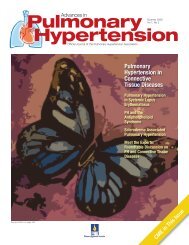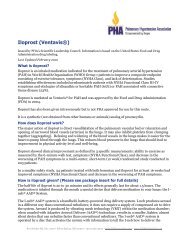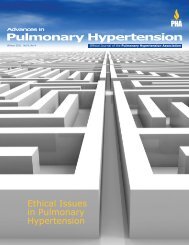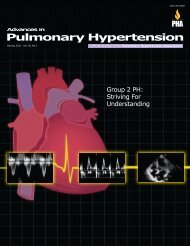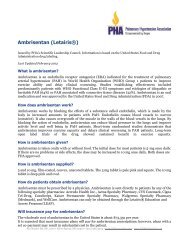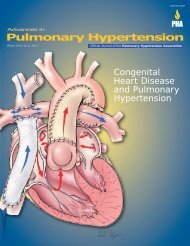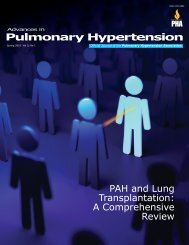Vol 7, No 3 - PHA Online University
Vol 7, No 3 - PHA Online University
Vol 7, No 3 - PHA Online University
You also want an ePaper? Increase the reach of your titles
YUMPU automatically turns print PDFs into web optimized ePapers that Google loves.
64. Gilde AJ, van der Lee KA, Willemsen PH, et al. Peroxisome proliferatoractivated<br />
receptor (PPAR) alpha and PPARbetaq/delta, but not PPARgamma,<br />
modulate the expression of genes involved in cardiac lipid metabolism. Circ<br />
Res. 2003;92:518-524.<br />
65. Tu N, Chen H, Winnikes U, et al. Molecular cloning and functional characterization<br />
of the promoter region of the human uncoupling protein-2 gene.<br />
I. 1999;265:326-334.<br />
66. Roussel D, Chainier F, Rouanet J, Barre H. Increase in the adenine nucleotide<br />
translocase content of duckling subsarcolemmal mitochondria during<br />
cold acclimation. I. 2000;477:141-144.<br />
67. Skulachev VP. Anion carriers in fatty acid-mediated physiological uncoupling.<br />
J Bioenerg Biomembr. 1999;31:431-445.<br />
68. Nishikawa T, Edelstein D, Du XL, et al. <strong>No</strong>rmalizing mitochondrial superoxide<br />
production blocks three pathways of hyperglycaemic damage. Nature.<br />
2000;404:787-790.<br />
69. Yamagishi SI, Edelstein D, Du XL, Kaneda Y, Guzman M, Brownlee M.<br />
Leptin induces mitochondrial superoxide production and monocyte chemoattractant<br />
protein-1 expression in aortic endothelial cells by increasing fatty acid<br />
oxidation via protein kinase A. J Biol Chem. 2001;276:25096-25100.<br />
70. Bonnefont-Rousselot D. Glucose and reactive oxygen species. Curr Opin<br />
Clin Nutr Metab Care. 2002;5:561-568.<br />
71. Evans J L, Goldfine I D, Maddux BA, Grodsky GM. Are oxidative stress-activated<br />
signaling pathways mediators of insulin resistance and b-cell dysfunction?<br />
Diabetes. 2003;52:1-8.<br />
72. Rosen P, Du X, Sui GZ. Molecular mechanisms of endothelial dysfunction<br />
in the diabetic heart. Adv Exp Med Biol. 2001;498:75-86.<br />
73. Marra G, Cotroneo P, Pitocco D, et al. Early increase of oxidative stress and<br />
reduced antioxidant defenses in patients with uncomplicated type 1 diabetes:<br />
a case for gender difference. Diabetes Care. 2002;25:370-375.<br />
74. Van Dam PS, Van Asbeck, BS, Erkelens DW, Marx JJ, Gispen WH, Bravenboer<br />
B. The role of oxidative stress in neuropathy and other diabetic complications.<br />
Diabetes Metab Rev. 1995;11:181-192.<br />
75. Kristal BS, Jackson CT, Chung HY, Matsuda M, Nguyen HD, Yu,BP. Defects<br />
at center P underlie diabetes-associated mitochondrial dysfunction. Free<br />
Radical Biol Med. 1997;22:823-833.<br />
76. Giardino I, Edelstein D, Brownlee M. BCL-2 expression or antioxidants<br />
prevent hyperglycemia-induced formation of intracellular advanced glycation<br />
endproducts in bovine endothelial cells. J Clin Invest. 1996;97:1422-1428.<br />
77. Lashin OM, Szweda PA, Szweda LI, Romani AM. Decreased complex II respiration<br />
and HNE-modified SDH subunit in diabetic heart. Free Radical Biol<br />
Med. 2006;40:886-896.<br />
78. Ye G, Metreveli NS, Donthi RV, et al. Catalase protects cardiomyocyte<br />
function in models of type 1 and type 2 diabetes. Diabetes. 2004;53:1336-<br />
1343.<br />
79. Shen X, Zheng S, Metreveli NS, Epstein PN. Protection of cardiac mitochondria<br />
by overexpression of MnSOD reduces diabetic cardiomyopathy. Diabetes.<br />
2006;55:798-805.<br />
80. Shen X, Zheng S, Thongboonkerd V, et al. Cardiac mitochondrial damage<br />
and biogenesis in a chronic model of type 1 diabetes. Am J Physiol Endocrinol<br />
Metab. 2004;287:E896-E905.<br />
81. Santos DL, Palmeira CM, Seica R, et al. Diabetes and mitochondrial oxidative<br />
stress: a study using heart mitochondria from the diabetic Goto-Kakizaki<br />
rat. Mol Cell Biochem. 2003;246:163-170.<br />
82. Conti M, Renaud IM, Poirier B, et al. High levels of myocardial antioxidant<br />
defense in aging nondiabetic normotensive Zucker obese rats. Am J Physiol<br />
Regul Integr Comp Physiol. 2004;286:R793-R800.<br />
83. Vincent HK, Powers SK, Stewart DJ, Shanely RA, Demirel H, Naito H.<br />
Obesity is associated with increased myocardial oxidative stress. Int J Obes<br />
Relat Metab Disord. 1999;23:67-74.<br />
84. Bugger H, Boudina S, Hu XX, et al. Type 1 diabetic akita mouse hearts<br />
are insulin sensitive but manifest structurally abnormal mitochondria that remain<br />
coupled despite increased uncoupling protein 3. Diabetes. 2008;57:<br />
2924-232.<br />
85. Balaban RS. Cardiac energy metabolism homeostasis: role of cytosolic<br />
calcium. J Mol Cell Cardiol. 2002;34:1259-1271.<br />
86. Bouchard RA, Bose D. Influence of experimental diabetes on sarcoplasmic<br />
reticulum function in rat ventricular muscle. Am J Physiol. 1991;260:<br />
H341-H354.<br />
87. Lagadic-Gossmann D, Buckler KJ, Le Prigent K, Feuvray D. Altered Ca2+<br />
handling in ventricular myocytes isolated from diabetic rats. Am J Physiol.<br />
1996;270:H1529-H1537.<br />
88. Penpargkul S, Fein F, Sonnenblick EH, Scheuer J. Depressed cardiac sarcoplasmic<br />
reticular function from diabetic rats. J Mol Cell Cardiol. 1981;13:<br />
303-309.<br />
89. Netticadan T, Temsah RM, Kent A, Elimban V, Dhalla NS. Depressed levels<br />
of Ca2+-cycling proteins may underlie sarcoplasmic reticulum dysfunction<br />
in the diabetic heart. Diabetes. 2001;50:2133-2138.<br />
90. Russ M, Reinauer H, Eckel J. Diabetes-induced decrease in the mRNA<br />
coding for sarcoplasmic reticulum Ca2+-ATPase in adult rat cardiomyocytes.<br />
Biochem Biophys Res Commun. 1991;178:906-912.<br />
91. Zhong Y, Ahmed S, Grupp IL, Matlib MA. Altered SR protein expression<br />
associated with contractile dysfunction in diabetic rat hearts. Am J Physiol.<br />
2001;281:H1137-H1147.<br />
92. Trost SU, Belke DD, Bluhm WF, Meyer M, Swanson E, Dillmann WH. Overexpression<br />
of the sarcoplasmic reticulum Ca2+-ATPase improves myocardial<br />
contractility in diabetic cardiomyopathy. Diabetes. 2002;51:1166-1171.<br />
93. Vetter R, Rehfeld U, Reissfelder C, et al. Transgenic overexpression of the<br />
sarcoplasmic reticulum Ca2+ATPase improves reticular Ca2+ handling in normal<br />
and diabetic rat hearts. FASEB J. 2002;16:1657-1659.<br />
94. Belke DD, Betuing S, Tuttle MJ, et al. Insulin signaling coordinately regulates<br />
cardiac size, metabolism, and contractile protein isoform expression. J<br />
Clin Invest. 2002;109:629-639.<br />
95. Hu P, Zhang D, Swenson L, Chakrabarti G, Abel ED, Litwin SE. Minimally<br />
invasive aortic banding in mice: effects of altered cardiomyocyte insulin signaling<br />
during pressure overload. Am J Physiol Heart Circ Physiol. 2003;285:<br />
H1261-H1269.<br />
96. McQueen AP, Zhang D, Hu P, et al. Contractile dysfunction in hypertrophied<br />
hearts with deficient insulin receptor signaling: possible role of reduced<br />
capillary density. J Mol Cell Cardiol. 2005;39:882-892.<br />
336 Advances in Pulmonary Hypertension



